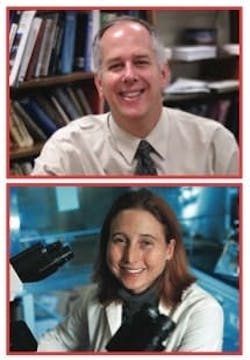About the author: James Smith is a professor for the Department of Civil and Environmental Engineering at the University of Virginia. Smith can be reached at [email protected]. Rebecca Dillingham is director of the Center for Global Health at the University of Virginia. Dillingham can be reached at [email protected]. Williette Nyanue is assistant editor for Water Quality Products. Nyanue can be reached at [email protected] or 847.954.7922.
PureMadi is a nonprofit organization dedicated to improving water quality and quantity. WQP Assistant Editor Williette Nyanue spoke with James Smith and Rebecca Dillingham of PureMadi to learn how the organization is using ceramic filtration technology to bring clean water to rural South Africa.
Williette Nyanue: How do ceramic filters work?
James Smith: The filters work through a combination of physical filtration and chemical disinfection. When [ceramic filters] are fabricated, clay, water and sawdust are mixed together and pressed into the shape of a filter pot. When the pot is fired, the clay hardens and the sawdust combusts, leaving a high porosity in the ceramic. If water flows through, particles of turbidity and suspended particles are removed by physical filtration. After firing, colloidal silver—an aqueous suspension of silver nanoparticles—typically is applied to the ceramic filter. The nanoparticles lodge in the core space of the filter. It turns out the silver nanoparticles are very effective antimicrobial agents, so the water is thus disinfected.
Nyanue: How were the PureMadi ceramic filters created?
Smith: Our work began in the laboratory because I was skeptical about the Potters for Peace [ceramic] filter; I didn’t think it would work. So we began performing tests in our labs here at the University of Virginia, and we found [the filters] to be highly effective. With help from Potters for Peace and the Ixtatan Foundation, a filter factory was established in San Mateo Ixtatan, Guatemala. The filters made there then were tested in the community and again performed well. Also, the filters were socially acceptable, and almost all users were still using their filters after two years. Then we moved to South Africa to test the filters to see if they worked to improve human health.
Rebecca Dillingham: We have done three years of market research and the product is highly desired and also has been effective: We did a randomized control trial with people living with HIV that showed that the use of the ceramic filter in the household substantially reduced the number of days of diarrhea. So we know that it is effective in terms of human health outcomes in that context and in more than a year of follow up. We also know that people loved having them in their homes.
Nyanue: How does the MadiDrop work?
Smith: The MadiDrop is a ceramic purification tablet that gradually releases trace amounts of silver and/or copper when dropped into solutions. This controlled release results in effective disinfection of a wide range of waterborne pathogenic microorganisms.
Dillingham: The other way that we would use the MadiDrop would be in conjunction with the ceramic water filter to provide a residual disinfection in the reservoir that collects the water that has come through the filter, because in some cases we have seen that the reservoir can be re-contaminated if it is not properly cleaned. Putting the MadiDrop in the reservoir and using it in conjunction with the ceramic filter is what we think will make the optimal product.
Nyanue: What inspired the MadiDrop?
Dillingham: We had concerns about the relative complexity of producing our full ceramic filters. The filters require a plastic bucket, a spigot and a good deal of storage space [in the home]. While they are easier to produce than a lot of things, in a resource-limited setting, their production is not trivial. We were hoping to find something that was easier to produce and transport to areas that were most in need.
Nyanue: What is the next step for these filters?
Dillingham: We are excited about the commercial launch of the ceramic filter and then the field testing of the MadiDrop, and delighted that we have been able to work closely with South African partners at the University of Venda and also with the municipality and the South African Board of Standards, to make sure that we are providing a efficacious and approved product that meets all local standards.
Download: Here
